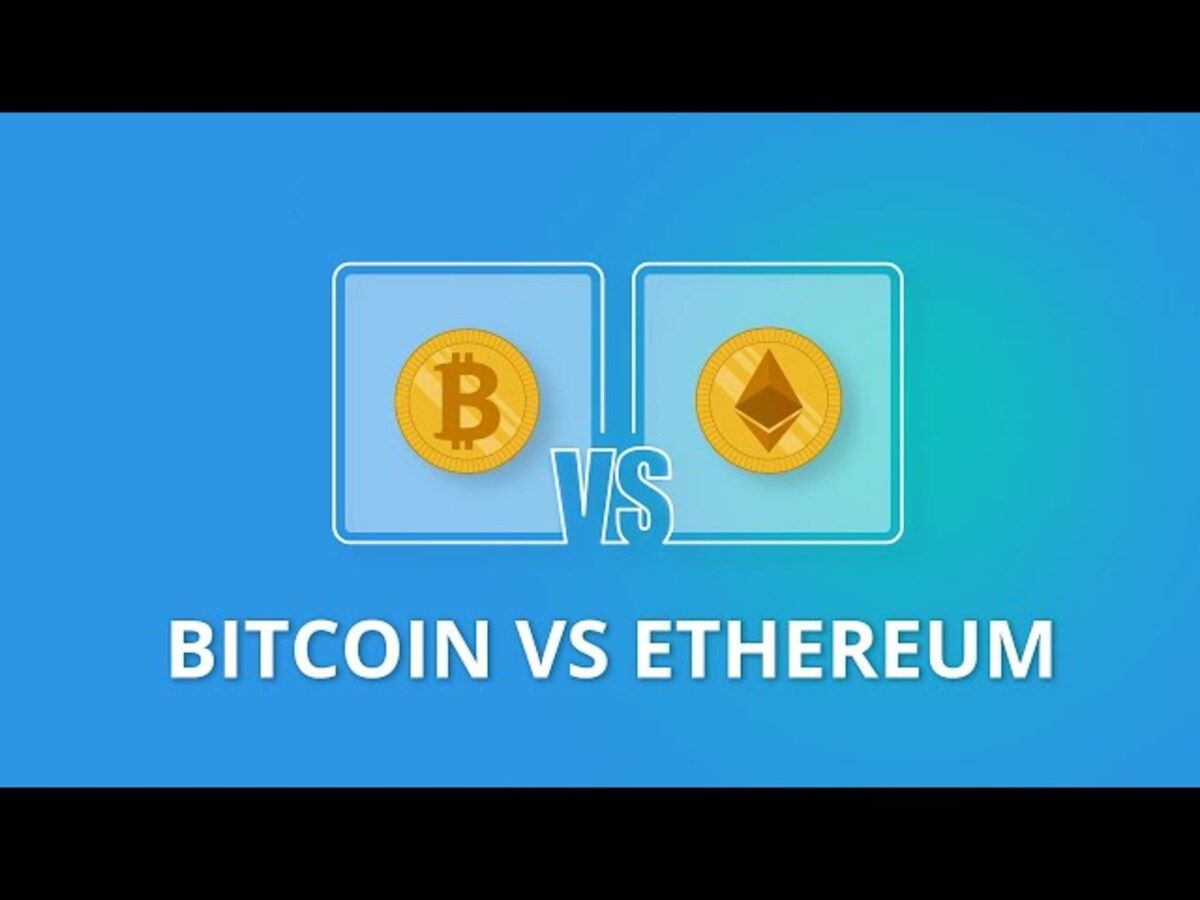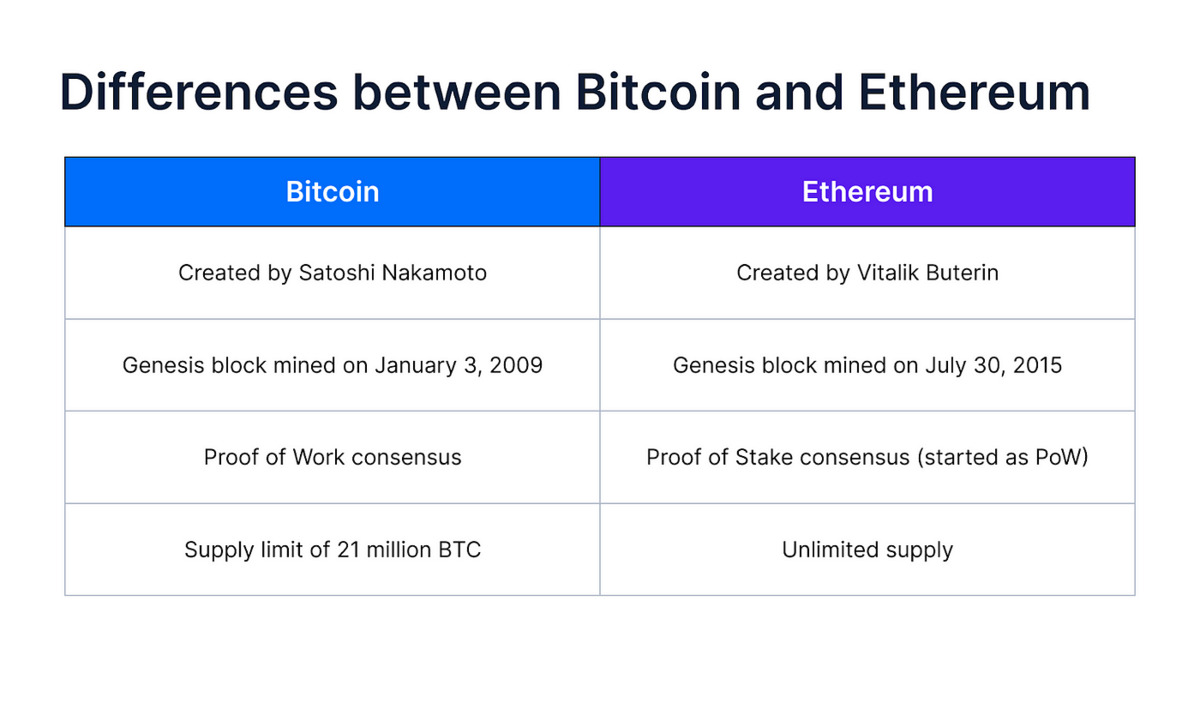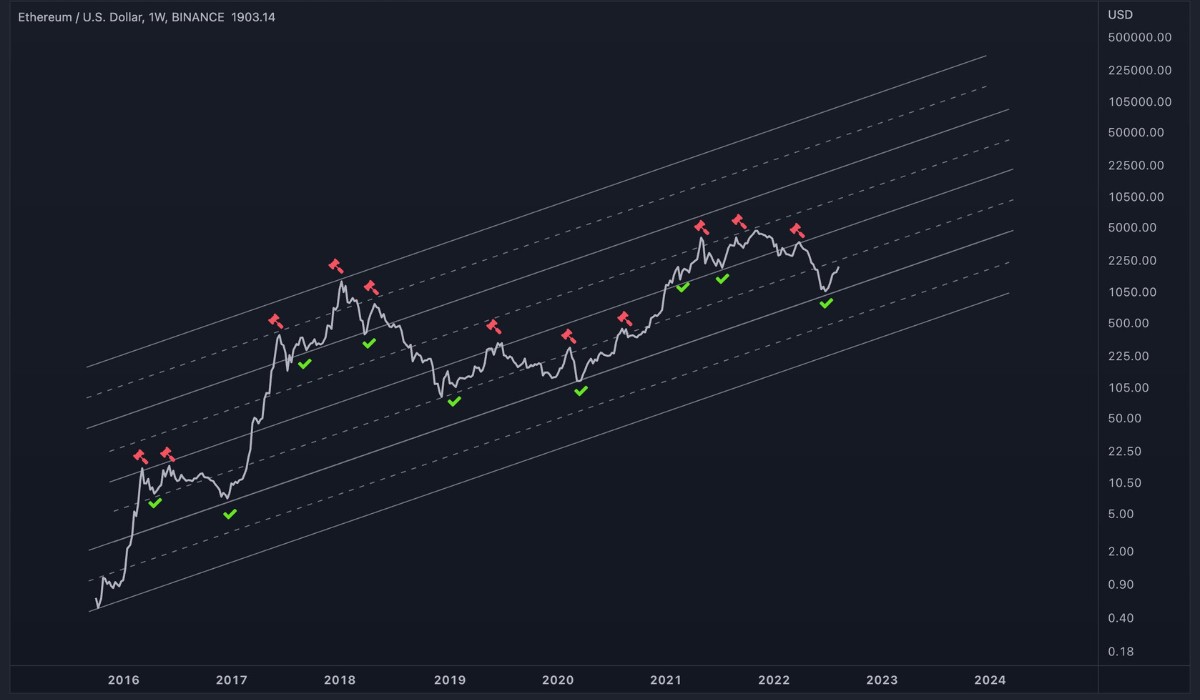Introduction
Welcome to the exciting world of cryptocurrency! Bitcoin and Ethereum are two of the most well-known and widely used digital currencies in the market today. Both have gained popularity and generated significant buzz in the financial industry. While some consider Bitcoin as the gold standard of cryptocurrencies, Ethereum has quickly emerged as a formidable competitor. In this article, we will delve deeper into the key similarities and differences between Bitcoin and Ethereum, examining their market value, transaction speed, smart contract capabilities, community and governance, as well as security and privacy features.
Bitcoin, created by an anonymous person (or group) known as Satoshi Nakamoto in 2009, was the first decentralized digital currency. It operates on a peer-to-peer network, allowing users to make transactions directly without the need for intermediaries like banks or governments. Bitcoin’s primary use case is as a decentralized store of value and a medium of exchange.
Ethereum, introduced by Vitalik Buterin in 2015, takes cryptocurrency a step further by providing a decentralized platform that enables developers to build and deploy smart contracts and decentralized applications (DApps). Ethereum’s native currency, known as Ether (ETH), not only functions as a digital currency but also powers the Ethereum network by compensating the computational resources required to execute smart contracts.
Both Bitcoin and Ethereum utilize blockchain technology, a distributed ledger system that ensures transparency, security, and immutability. Additionally, they can be bought, sold, and traded on various cryptocurrency exchanges.
Bitcoin and Ethereum have their unique characteristics, use cases, and communities. Understanding their similarities and differences is crucial for individuals and businesses looking to enter the realm of digital currencies. So, let’s dive into the world of Bitcoin and Ethereum and compare their features and capabilities.
Comparison of Bitcoin and Ethereum
Bitcoin and Ethereum are often compared due to their popularity and influence in the world of cryptocurrencies. While they share certain similarities, they also differ in terms of purpose, technology, and scalability.
Similarities between Bitcoin and Ethereum:
- Blockchain Technology: Both Bitcoin and Ethereum operate on blockchain technology, ensuring decentralized and transparent transactions.
- Decentralization: Neither Bitcoin nor Ethereum is controlled by a central authority, such as a government or financial institution.
- Volatility: Both currencies are known for their price volatility, which makes them attractive to investors and traders seeking potential high returns.
- Investment: Bitcoin and Ether can be bought as an investment, with the hope that their value will increase over time.
Differences between Bitcoin and Ethereum:
- Purpose: Bitcoin is primarily designed to serve as a digital currency and a store of value, while Ethereum focuses on providing a platform for building decentralized applications and executing smart contracts.
- Technology: Bitcoin uses a Proof-of-Work (PoW) consensus algorithm, which requires high computational power and electricity consumption. Ethereum, on the other hand, is transitioning to a Proof-of-Stake (PoS) consensus algorithm, which is more energy-efficient.
- Scalability: Bitcoin’s block size limitation makes it slower in terms of transaction speed and scalability. Ethereum, although facing similar challenges, has been working on solutions like Ethereum 2.0 to improve its scalability.
- Smart Contracts: Ethereum is known for its robust smart contract functionality, allowing developers to create and deploy self-executing contracts with predefined conditions. Bitcoin, while capable of hosting simple smart contracts, is more focused on its use as a cryptocurrency.
It is worth noting that Bitcoin and Ethereum have different communities and governance structures. Bitcoin has a smaller and more focused community, with decisions about the network largely driven by consensus. Ethereum has a larger and more diverse community, with various stakeholders influencing the direction of the platform.
In terms of security and privacy, both Bitcoin and Ethereum offer a level of anonymity, as transactions are pseudonymous. However, they are not completely private, as the transaction history can be traced on the blockchain.
While Bitcoin remains the most widely recognized and adopted cryptocurrency, Ethereum’s platform capabilities and potential for innovation have positioned it as a significant player in the industry. Both cryptocurrencies have unique strengths and weaknesses that individuals and businesses should consider when evaluating their use cases and potential for investment.
Similarities between Bitcoin and Ethereum
Bitcoin and Ethereum, two of the most prominent cryptocurrencies in the market, share several similarities that contribute to their overall popularity and influence. While they have distinct features and purposes, there are some key areas where they align:
- Blockchain Technology: Both Bitcoin and Ethereum utilize blockchain technology, which serves as a decentralized and transparent transaction ledger. The fundamental principle of blockchain, where transactions are recorded on a distributed network of computers, ensures data integrity and security.
- Decentralization: One of the primary reasons for the success of Bitcoin and Ethereum is their decentralized nature. These cryptocurrencies are not controlled by any central authority, such as governments or financial institutions, allowing users to have full ownership and control over their digital assets.
- Volatility: Bitcoin and Ethereum are known for their price volatility. Their values can experience sharp fluctuations over short periods, which can present both opportunities and risks for investors and traders.
- Investment Opportunities: Both Bitcoin and Ethereum offer investment opportunities. Investors can purchase these cryptocurrencies with the expectation that their value will increase over time. The growing interest and adoption of digital currencies have made them a popular choice for investment portfolios.
These shared characteristics have contributed to the widespread recognition and acceptance of Bitcoin and Ethereum within the cryptocurrency community. The utilization of blockchain technology and the benefits of decentralization offer users a secure and transparent means of conducting transactions and managing digital assets.
Furthermore, the volatility of Bitcoin and Ethereum has attracted the attention of traders and investors seeking financial gains. Their potential for substantial price movements has propelled these cryptocurrencies into the mainstream financial space, with individuals and institutions alike showing interest in leveraging their investment potential.
It is important to note that while Bitcoin and Ethereum share these similarities, they also have distinct features and purposes. Understanding the similarities and differences between these two cryptocurrencies is essential in order to make informed decisions and navigate the dynamic landscape of the cryptocurrency market.
Now that we have explored the similarities between Bitcoin and Ethereum, let’s delve into their differences to gain a comprehensive understanding of these popular digital currencies.
Differences between Bitcoin and Ethereum
While Bitcoin and Ethereum share certain similarities, they also have significant differences that set them apart in terms of purpose, technological aspects, and scalability. Understanding these differences is crucial for discerning their respective strengths and use cases. Here are the key distinctions between Bitcoin and Ethereum:
- Purpose: Bitcoin was created primarily as a digital currency, aiming to be a decentralized medium of exchange and store of value. Ethereum, on the other hand, was designed to go beyond mere currency and act as a decentralized platform for building and executing smart contracts and decentralized applications (DApps).
- Technology: Bitcoin and Ethereum employ different underlying technologies. Bitcoin uses a Proof-of-Work (PoW) consensus algorithm, requiring high computational power and energy consumption to mine new coins and validate transactions. Ethereum, however, is in the process of transitioning to a more energy-efficient Proof-of-Stake (PoS) consensus algorithm with Ethereum 2.0, where validators are chosen based on the amount of cryptocurrency held and staked.
- Scalability: Bitcoin faces scalability challenges due to its limited block size, resulting in slower transaction speeds and higher fees during periods of network congestion. Ethereum, too, has experienced scalability difficulties, but Ethereum 2.0 aims to alleviate these concerns with the implementation of shard chains and a more efficient consensus mechanism. Ethereum’s focus on facilitating smart contract execution also presents unique scalability considerations.
- Smart Contracts: While both Bitcoin and Ethereum support smart contracts, Ethereum is particularly known for its robust smart contract capabilities. Ethereum allows developers to create and deploy self-executing contracts with predefined rules and conditions, enabling the automation of complex transactions and interactions without intermediaries. Bitcoin, on the other hand, primarily supports simple smart contracts that facilitate basic functions like multisig transactions.
- Community and Governance: Bitcoin and Ethereum also differ in terms of their communities and governance structures. Bitcoin has a relatively smaller and more focused community, where decisions on network upgrades are made through consensus among participants. In contrast, Ethereum has a larger and more diverse community that includes developers, miners, investors, and users, with decisions influenced by discussions, proposals, and Ethereum Improvement Proposals (EIPs).
- Security and Privacy: Bitcoin and Ethereum offer a certain level of anonymity through pseudonymous transactions. However, they differ in terms of privacy features. Bitcoin transactions are generally more transparent and traceable, allowing public scrutiny of transaction history. The privacy features of Ethereum, on the other hand, depend on the implementation of additional protocols, such as zero-knowledge proofs, to enhance privacy and confidentiality.
These differences highlight the distinct purposes and capabilities of Bitcoin and Ethereum. Bitcoin, with its focus on being a decentralized digital currency, has established itself as a widely recognized and accepted cryptocurrency. Ethereum, with its advanced smart contract functionality and platform capabilities, has positioned itself as a powerhouse for blockchain-based applications and innovations.
By understanding the differences between Bitcoin and Ethereum, users can make informed decisions based on their specific needs and objectives, be it as a currency, an investment, or a platform for decentralized applications.
Market Value and Adoption
Bitcoin and Ethereum have both experienced significant market value growth and achieved widespread adoption within the cryptocurrency ecosystem. Let’s explore their market value and adoption trends to better understand their positions in the digital currency landscape.
Bitcoin:
Bitcoin is undoubtedly the most well-known and established cryptocurrency. Since its inception, Bitcoin has gained considerable recognition and adoption, becoming a household name among investors and the general public. As of [insert current date], the market capitalization of Bitcoin stands at [insert figure], making it the largest cryptocurrency by market value.
Bitcoin’s rapid rise in value over the years has attracted a broad user base, ranging from individual investors and traders to institutional players. It has established itself as a legitimate asset class, with many institutional investors including Bitcoin in their portfolios as a hedge against traditional financial markets.
Additionally, Bitcoin has seen increasing acceptance as a medium of exchange. Numerous businesses, including some major retailers, have started accepting Bitcoin as a form of payment. This growing acceptance further enhances Bitcoin’s reputation and viability as a digital currency.
Ethereum:
Ethereum, while not as well-known as Bitcoin, has made significant strides in terms of market value and adoption. As of [insert current date], Ethereum has the second largest market capitalization among cryptocurrencies.
Ethereum’s primary adoption driver is its position as a platform for decentralized applications and smart contracts. It has attracted developers and entrepreneurs who leverage its capabilities to build innovative applications and services. The Ethereum ecosystem is vibrant and diverse, with a wide range of projects and tokens being developed and utilized.
Similar to Bitcoin, Ethereum has garnered the attention of institutional investors as well. Projects and protocols built on Ethereum have attracted significant investments, contributing to the platform’s growing market value and legitimizing its position in the cryptocurrency space.
Comparison:
In terms of market value, Bitcoin continues to dominate the cryptocurrency market, with a considerably higher market capitalization compared to Ethereum. Bitcoin’s wider recognition and longer track record have played a pivotal role in establishing its market dominance.
However, it is essential to note that Ethereum’s market capitalization and adoption have grown substantially over the past few years. Its unique capabilities as a platform for decentralized applications and smart contracts have attracted a diverse range of users and developers, positioning Ethereum as a strong contender in the crypto space.
Both Bitcoin and Ethereum have witnessed increasing acceptance and adoption by individuals, businesses, and institutions. As the cryptocurrency market evolves and matures, their market value and adoption are likely to continue growing, albeit potentially at different rates and with varying degrees of influence.
Overall, Bitcoin’s market value and adoption are more established, but Ethereum’s distinctive features and platform capabilities have propelled its adoption and market capitalization, creating an exciting landscape for both cryptocurrencies in the cryptocurrency market.
Transaction Speed and Scalability
Transaction speed and scalability are crucial factors to consider when evaluating the efficiency and usability of cryptocurrencies like Bitcoin and Ethereum. Let’s examine how these two popular digital currencies compare in terms of transaction speed and scalability:
Bitcoin:
Bitcoin’s transaction speed has been a subject of debate and criticism due to its design and consensus mechanism. The average block time for Bitcoin is around 10 minutes, meaning transactions must wait for confirmation in the next block to be considered final. This can result in longer settlement times, especially during periods of high network congestion.
Bitcoin’s scalability has also been a challenge due to its limited block size. Currently, the block size of Bitcoin is 1MB, which restricts the number of transactions that can be included in each block. As a result, the network can become congested, leading to higher transaction fees and longer confirmation times.
Ethereum:
Ethereum has faced similar scalability challenges, albeit with some efforts to address them. The average block time for Ethereum is lower than Bitcoin, around 15 seconds, which allows for faster confirmation of transactions. However, it is worth noting that transaction speed can still vary depending on network conditions and congestion.
Efforts are underway to improve Ethereum’s scalability through the implementation of Ethereum 2.0. This upgrade aims to enhance the network’s capacity by introducing shard chains and transitioning to a more energy-efficient Proof-of-Stake consensus algorithm. These developments are expected to significantly improve transaction speed and scalability on the Ethereum network.
Comparison:
Overall, it is clear that Bitcoin lags behind Ethereum in terms of transaction speed and scalability. The longer block time and smaller block size of Bitcoin result in slower confirmation times and limited capacity. This can pose challenges during periods of high transaction volume, leading to increased fees and delays.
While Ethereum also faces scalability challenges, its average block time is significantly faster than that of Bitcoin. Ethereum’s ongoing efforts to implement Ethereum 2.0 demonstrate a commitment to addressing scalability concerns and improving transaction speeds. These improvements, once fully implemented, are expected to significantly enhance Ethereum’s scalability and transaction capabilities.
It is worth noting that transaction speed and scalability are important considerations for various use cases. For example, Bitcoin’s slower settlement times may be less critical for certain long-term investments or large transactions. On the other hand, Ethereum’s faster confirmation and transaction speeds make it more suitable for applications requiring real-time interactions or rapid transaction processing, such as decentralized finance (DeFi) protocols and gaming platforms.
As the demand for cryptocurrencies and blockchain-based applications continues to grow, transaction speed and scalability will remain pivotal factors in determining the usability and adoption of Bitcoin, Ethereum, and other digital currencies. Ongoing research and development efforts aim to improve these aspects, ensuring that cryptocurrencies can meet the needs of a rapidly evolving digital economy.
Smart Contract and Development Capabilities
Smart contracts are an essential feature of blockchain technology that enable the self-execution of predefined conditions without the need for intermediaries. Bitcoin and Ethereum approach smart contracts and development capabilities differently, providing distinct opportunities for developers and users.
Bitcoin:
While Bitcoin is primarily known for its use as a digital currency, it does have limited smart contract capabilities. Bitcoin’s scripting language allows for the creation of simple smart contracts, such as multi-signature transactions, which require multiple entities to sign off on a transaction for it to be executed.
Bitcoin’s scripting language intentionally has a limited set of instructions to ensure security and prevent potential vulnerabilities. While this limits the complexity of smart contracts that can be created on the Bitcoin network, it also contributes to the network’s robustness.
Ethereum:
Ethereum sets itself apart from Bitcoin by providing a powerful platform for building and deploying smart contracts. Ethereum’s native programming language, Solidity, enables developers to create complex smart contracts with sophisticated logic and conditions.
Additionally, Ethereum supports the development of decentralized applications (DApps), which are built on top of its platform. DApps can leverage the functionality of smart contracts to automate various processes and operations, providing a wide range of services and experiences to users.
Ethereum’s flexibility allows developers to create decentralized finance (DeFi) protocols, decentralized exchanges (DEXs), gaming platforms, and more. The rich ecosystem of Ethereum-based projects and tokens attests to the platform’s extensive development capabilities.
Comparison:
While both Bitcoin and Ethereum offer smart contract capabilities, Ethereum’s platform is far more advanced in terms of development opportunities. Ethereum’s focus on enabling developers to build complex smart contracts and DApps has positioned it as a leader in the space.
Bitcoin’s limited scripting language allows for the creation of simpler smart contracts, which are primarily centered around the cryptocurrency’s use as a medium of exchange and store of value.
It is important to note that the design choices of each blockchain, Bitcoin and Ethereum, cater to different use cases. Bitcoin’s emphasis on security and stability makes it well-suited for financial transactions, while Ethereum’s focus on programmability and flexibility allows for the development of more intricate applications.
Ultimately, the selection of Bitcoin or Ethereum for a specific project or application will depend on the desired functionality and complexity of the smart contracts to be implemented. Developers and users should consider their unique requirements, use cases, and the ecosystem surrounding each blockchain.
Both Bitcoin and Ethereum have made significant contributions to the advancement of smart contract and blockchain technology. Their differing approaches to smart contracts and development capabilities provide options for developers and users seeking to harness the potential of decentralized applications and automated agreements.
Community and Governance
Community and governance play vital roles in the success and evolution of blockchain networks like Bitcoin and Ethereum. The communities surrounding these cryptocurrencies have distinct characteristics and governance structures that influence their development and decision-making processes.
Bitcoin:
The Bitcoin community consists of a diverse range of individuals and organizations, including miners, developers, investors, and users. Bitcoin’s community is known for its passion and unwavering belief in the principles of decentralization and financial sovereignty. Early adopters and enthusiasts have helped nurture the growth and widespread acceptance of Bitcoin.
In terms of governance, Bitcoin operates on a consensus-driven model. Decisions regarding network upgrades and improvements are made through the participation and agreement of relevant stakeholders. This decentralized governance structure ensures that no single entity holds absolute control over the direction of the network.
Ethereum:
The Ethereum community is expansive and dynamic, encompassing developers, entrepreneurs, researchers, and users from around the world. Ethereum’s community boasts a vibrant ecosystem of projects, collaborations, and discussions, driven by a shared vision of decentralized applications and smart contract capabilities.
Governance within the Ethereum community is more structured and relies on various mechanisms. EIP (Ethereum Improvement Proposal) is the formal process for proposing and discussing improvements to the Ethereum protocol. Stakeholders can voice opinions and contribute to discussions through community platforms and forums.
Ethereum’s governance structure also includes decision-making by core development teams and decentralized autonomous organizations (DAOs). This multi-faceted governance approach allows for a balance of expertise, stakeholder input, and consensus-driven decision-making.
Comparison:
While both Bitcoin and Ethereum have passionate and engaged communities, their governance models differ in terms of structure and decision-making processes.
Bitcoin’s governance is more organic and driven by the consensus of participants. This approach aligns with the core principles of decentralization and distribution of power. The community-driven decision-making process reflects the collective will of Bitcoin stakeholders.
Ethereum’s governance, on the other hand, incorporates a more formalized and structured approach. EIPs, core development teams, and DAOs contribute to decision-making, fostering discussions and providing opportunities for diverse perspectives to be considered.
Both governance models have strengths and weaknesses. Bitcoin’s decentralized consensus-driven model ensures a balance of power among participants but may be slower and less structured in terms of decision-making. Ethereum’s more organized governance structure allows for more rapid progress but requires careful consideration and coordination to maintain inclusivity and decentralization.
The communities and governance structures of Bitcoin and Ethereum are key factors in their growth and ongoing development. The resilience and dedication of their communities, combined with their unique governance models, contribute to the continuous evolution and adaptation of these blockchain networks.
Collaboration and open dialogue within these communities foster innovation, contributing to the overall advancement of the blockchain industry as a whole.
Security and Privacy
Security and privacy are crucial considerations when it comes to cryptocurrencies like Bitcoin and Ethereum. Both networks implement measures to ensure the protection of user assets and data, although they differ in certain aspects. Let’s explore the security and privacy features of Bitcoin and Ethereum:
Bitcoin:
Bitcoin is renowned for its robust security framework, which has been tested and proven over its decade-long existence. The security of the Bitcoin network primarily relies on the decentralized nature of its blockchain and the use of cryptographic techniques.
The decentralized consensus mechanism, known as Proof-of-Work (PoW), makes it extremely difficult for malicious actors to tamper with the blockchain records. Miners invest computational power and energy to validate and secure transactions, ensuring the integrity of the network.
In terms of privacy, Bitcoin transactions are pseudonymous, meaning that they are not directly linked to the identities of the participants. However, the transaction history is public and can be analyzed, potentially revealing patterns or associations between addresses. Enhancing privacy in Bitcoin transactions often requires additional tools such as mixing services or privacy-focused wallets.
Ethereum:
Similar to Bitcoin, Ethereum employs strong security measures, but it also incorporates additional features for enhanced privacy. The Ethereum network benefits from the same decentralized consensus mechanism as Bitcoin but is undergoing a transition from Proof-of-Work (PoW) to Proof-of-Stake (PoS) with Ethereum 2.0. The PoS algorithm is designed to increase energy efficiency and security while reducing the risk of certain attacks.
Ethereum offers more advanced privacy features with the potential to protect sensitive information. Zero-knowledge proofs, for instance, can be utilized to perform transactions or execute smart contracts without exposing the underlying data. Privacy-focused projects and protocols, such as Tornado Cash and Aztec Protocol, are actively exploring methods to enhance privacy within the Ethereum ecosystem.
It’s worth mentioning that privacy on the Ethereum network is not automatically enforced and requires specific actions from users, such as utilizing privacy-focused solutions or implementing privacy-enhancing protocols.
Comparison:
Both Bitcoin and Ethereum prioritize security and implement robust measures to protect their networks. Bitcoin’s security has been thoroughly tested and has demonstrated its resilience over time. Ethereum, while younger, also maintains a strong security framework with ongoing efforts to improve through the transition to the PoS consensus algorithm.
When it comes to privacy, Bitcoin transactions are generally pseudonymous, while Ethereum provides more opportunities for advanced privacy features. However, achieving a high level of privacy on both networks often requires additional tools or solutions beyond their base functionality.
It’s important to note that while cryptocurrencies aim to provide security and privacy, users must also take personal responsibility for protecting their assets and information. Best practices, such as secure wallet management, strong authentication methods, and awareness of potential threats, are crucial for maintaining individual security and privacy within the cryptocurrency ecosystem.
As the industry progresses, the security and privacy features of Bitcoin, Ethereum, and other cryptocurrencies are expected to evolve, with ongoing exploration and innovation focused on creating safer and more private platforms for users.
Conclusion
Bitcoin and Ethereum are two prominent cryptocurrencies that have greatly influenced the digital currency landscape. While they share certain similarities, such as their utilization of blockchain technology, their purposes, features, and community dynamics set them apart.
Bitcoin, with its status as the pioneer in cryptocurrencies, is primarily recognized as a decentralized digital currency and a store of value. Its robust security, widespread adoption, and proven track record have made it a trusted and widely accepted cryptocurrency in the financial world.
Ethereum, on the other hand, offers a platform beyond currency, enabling developers to build decentralized applications and execute smart contracts. Its advanced smart contract capabilities, scalability solutions, and dynamic ecosystem have established Ethereum as a powerhouse for innovation and a hub for decentralized finance (DeFi) applications.
When comparing Bitcoin and Ethereum, it becomes clear that their unique features cater to different use cases. Bitcoin thrives as a digital currency with a stable and secure infrastructure, while Ethereum provides a more programmable platform with extensive development capabilities.
Both cryptocurrencies have passionate communities driving their growth and development. Bitcoin’s community embraces the principles of decentralization and financial sovereignty, shaping its governance through decentralized consensus. Ethereum’s dynamic and diverse community, on the other hand, fosters collaboration and structured discussions towards decision-making on network improvements.
While Bitcoin remains dominant in market value and adoption, Ethereum has gained popularity and influence with its platform for decentralized applications and smart contracts. Both cryptocurrencies continue to evolve and address scalability, transaction speed, security, and privacy to meet the demands of an expanding digital economy.
As the cryptocurrency industry advances, the continued development and maturation of Bitcoin and Ethereum, along with other innovative projects, is expected to shape the future of digital currencies and their applications. Investors, developers, and users should closely monitor the progress and advancements in these ecosystems to make informed decisions in this evolving landscape.

























